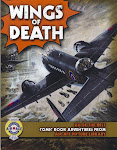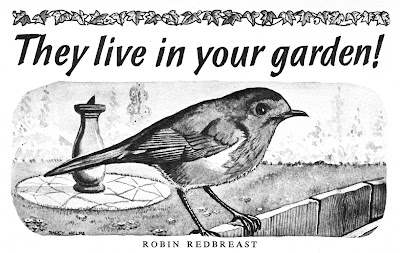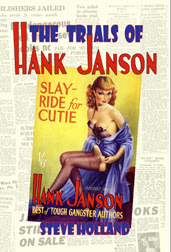 Len Fullerton is primarily known as a nature and wildlife artist but had an interesting career before that. The earliest trace of Fullerton I have found is in the late 1930s when, using the pen-name Nat Brand, he drew adventure and science fiction comic strips for various publishers, including 'Derickson Dene' (Triumph, 1939-40), 'Dandy McQueen of the Royal Mounted' (All Star, Comic Adventures, Red Star Comic, 1941-48), 'Crash Carew, Daredevil of the Stratosphere' (Comic Capers, Comic Adventures, 1941-49), 'Halcon, Lord of the Craters' (All Fun, Comic Capers, 1942-49) and various other strips for Soloway, a small war-time publisher who produced a number of comic titles irregularly until 1949. Fullerton was a member of Bill McCail's Mallard Studios in Dundee where he worked alongside many other comic artists including Sam Fair, George Blow, Alf Farningham and Sydney Jordan.
Len Fullerton is primarily known as a nature and wildlife artist but had an interesting career before that. The earliest trace of Fullerton I have found is in the late 1930s when, using the pen-name Nat Brand, he drew adventure and science fiction comic strips for various publishers, including 'Derickson Dene' (Triumph, 1939-40), 'Dandy McQueen of the Royal Mounted' (All Star, Comic Adventures, Red Star Comic, 1941-48), 'Crash Carew, Daredevil of the Stratosphere' (Comic Capers, Comic Adventures, 1941-49), 'Halcon, Lord of the Craters' (All Fun, Comic Capers, 1942-49) and various other strips for Soloway, a small war-time publisher who produced a number of comic titles irregularly until 1949. Fullerton was a member of Bill McCail's Mallard Studios in Dundee where he worked alongside many other comic artists including Sam Fair, George Blow, Alf Farningham and Sydney Jordan.Fullerton continued to draw comic strips in the 1950s, including 'Steve Sampson' for Sports Cartoons and various strips for Lone Star Magazine, annuals and other minor publications until around 1955. Fullerton also contributed to some of the classier comic annuals, including The Children's Own Wonder Book (London, Odhams Press, 1947), Eagle Annual, Swift Annual, Girl Annual and The Scout Story Omnibus (1955).
Fullerton was described as dark, stocky and cheerful with a charming smile by Colin Gibson. "As an artist Len is just about the most modest man I ever met. Yet he has, when one thinks of it, very little to be modest about. He is known to thousands by his magazine covers and drawings, and his newspaper sketches and notes... A lecturer who sketches as he describes, he has given delight to audiences over a wide area." He was elected and re-elected president of Dundee Naturalists' Society.
Len Fullerton was born in Aberdeen in 21 April 1909. He was not from an artistic family, there was a liking and enthusiasm for drawing; his brother and sisters could all draw well and young Len was envious of their ability to draw characters from Dickens in the manner of "Phiz". Fullerton was also a reader of Chums and Boy's Own Paper where he discovered the work of Stanley L. Wood; he would seek out examples of Wood's work, tracing his career back as early as a cowboy illustration in Young England.
Aside from drawing round the kitchen table, Len's great pleasure was to be outside in the woods and fields on Donside, rambling around the countryside on foot or by bike; as his artistic skills grew, he would always take his sketchbook and draw animals, birds, plants and insects.
Fullerton had no formal art training but continued to sketch whilst working in a variety of jobs. In his early teens, Fullerton was advised by an art dealer to send one of his drawings of a tree to the Royal Scottish Academy. It was accepted and a number of other pictures appeared at the R.S.A. before he became too busy with illustration work.
His first paid work was a picture for the closing sale of a local jewellery firm of a herald mounted on a horse with the caption "The House of Quality is passing!" He subsequently moved to Dundee where he found work as an illustrator in the city's Courier offices. He was also working in a music shop where he met his future wife. They were married in the mid-1930s, moving to Newport-on-Tay where they had three daughters.
During the war he worked in an aircraft factory in Dunbarton building Sunderland Flying Boats. His letters home were decorated with little drawings of insect-like men nicknamed "creechers" involved in all sorts of strange activities, frequently playing ancient instruments or wielding antique weapons and firearms; usually they were linked with birds, beasts or flowers. Mrs. Fullerton kept all these envelopes and some were exhibited at the Dundee Art Society.
After the war he was able to make his living as a freelance illustrator. In his early days he drew illustrations for boys' papers and comics, often writing the strips himself. One particularly satisfying piece was a full-page feature on cowboys, a cover feature for Boy's Own Paper with the cover being a stirring illustration by Stanley L. Wood. Fullerton also drew illustrations for romantic fiction and newspaper strips, including the cowboy serial 'Starlight' and the adventures of a wild fox, 'Red Tod'.
Gradually, he came to the realisation that he should be drawing the things he loved. He had been taking night classes in figure drawing and was also drawing from life whenever possible, using any obliging friend as a model. But his real interest still lay in drawing from nature and he spent every spare moment studying books on the techniques of painting and reproduction and on human and animal anatomy. "I studied animal anatomy because I realised that drawing from memory is all important for the nature artist," he later said. "I began to school myself in a method which I believe was used by Whistler and Legros for different ends. Now, besides drawing direct from nature whenever possible, I build up my subjects from observation in the field, intensively memorised.
"I try to achieve the feeling that if you stretch out a hand the bird will immediately spring into the air and away. In all my bird and animal pictures I attempt to get this feeling of aliveness and this, I think, can only be achieved by observation in the field and seizing the living lines."
Apart from illustrations in magazines, annuals and books, Fullerton also produced nature studies for postcards and greetings cards for Valentine; for many years he also drew an annual nature calendar for Valentines and, later, for Jarrolds. He also produced a regular nature strips for the Glasgow paper the Bulletin entitled 'Seen Out of Doors'; when that paper was discontinued, he began a new strip for the Daily Mail entitled 'In the Wild'. He did these pictures on scraperboard so that he could get very clear definition and detail.
Fullerton's favourite haunts were the shores of the local Tay and particularly Tentsmuir, near St. Andrews, which was designated a National Nature Reserve in 1952. The area was originally moorland but planting and drainage, started by the Forrestry Commission in the 1920s, meant that over the years the area became of great botanical interest. Land was gained from the sea and new conifers, planted a short distance above the high water mark, were, by the 1960s, half a mile away from the ocean. Fullerton recorded the changing face of Tentsmuir over the years in his illustrations and paintings and his thorough knowledge of the wildlife and conservation eaerned him the position of Honourary Warden of Tentsmuir Point and Morton Lochs National Nature Reserves.
Fullerton's daughter, Clare, recalls: "He was particularly fond of Tentsmuir and Morton Lochs. Over all thet years I can remember, he cycled down to Tayport every Sunday where he was joined by his friend, Mr. Ellis Crapper. Together they would cycle on to the moors. Mr. Crapper was a keen and knowledgable naturalist. They had a strong bond because of their shared interest.
"As young children, we would be in bed when we heard the latch on the garden gate open, and Dad would come into the garden pushing his bicycle across the gravel path to the shed. When he came into the house we would call, 'What did you see today?' and he would tell us about a squirrel he had watched or a trapped roe deer he had helped rescue or seals on the foreshore or young terns hatching out. There was always a story to tell. he must often have been tired after the long cycle run, but he would take time to tell us something of his day."
Fullerton died on 16 August 1968.
PUBLICATIONS
Non-fiction
Wild Flowers. London & Glasgow, Collins, 1966.
My First Nature Book. London, Thomas Nelson & Sons, 1967.
Trees. London, Collins & Glasgow, 1967.
Illustrated Books
Diddle the Gosling by Phyllis Kelway. London & Glasgow, Collins, 1947.
House by the Running Water by Phyllis Kelway. London & Glasgow, Collins, 1947.
Twinkle and Winkle, Two Dormice by Phyllis Kelway. London & Glasgow, Collins, 1947.
Bruno the Brown Owl by Phyllis Kelway. London & Glasgow, Collins, 1948.
Caw-Taw. The story of a rook by Katharine Margaret Wilson. London, Hutchinson's Books for Young People, 1948.
The Otter Who Came Back by Phyllis Kelway. London & Glasgow, 1948.
Tales of Wild Bird Life by Harry Mortimer Batten. London & Glasgow, Blackie & Son, 1948.
A Breath of Fresh Air by Warham Kay Robinson. London, Lutterworth Press, 1950.
Flip Squirrel by Kenneth Richmond. London & Glasgow, Blackie & Son, 1950.
Getting to Know Wild Animals by David Stephen. London & Glasgow, Collins, 1952.
The Story of Rakny by Annie Gladys Taylor. London & Glasgow, Blackie & Son, 1952.
The Adventures of Gerard, from The Cloister and the Hearth by Charles Reade, retold by L. M. Paulin. London & Edinburgh, W. & R. Chambers, 1956.
Jackaroos by E. M. Kitching. London & Edinburgh, W. & R. Chambers, 1956.
Birds and Their Eggs by David Stephen. London & Glasgow, Collins, 1958.
Zoo-Man Talks by T. H. Gillespie. Edinburgh, Oliver & Boyd, 1959.
Zoo-Man Stories by T. H. Gillespie. Edinburgh, Oliver & Boyd, 1960.
Zoo-Man Tales by T. H. Gillespie. Edinburgh, Oliver & Boyd, 1960; New York, Taplinger Publishing Co., 1960.
Wonders of Life by L. G. Humphrys. London, Blackie & Son, 4 vols., 1960-61.
More Birds and Their Eggs by David Stephen. London & Glasgow, Collins, 1961.
Zoo-Man Again by T. H. Gillespie. Edinburgh, Oliver & Boyd, 1961.
Do You Know About Reptiles and Amphibians? by David Stephen. London & Glasgow, Collins, 1963.
A Look at Living Things by B. R. Cox & O. C. Jenks. London, Blackie, 1969.
Others
An Exhibition of Drawings, Paintings and Published Illustrations of the artist-naturalist Len Fullerton compiled by Adam Ritchie. Dundee, Dundee City Museum and Art Gallery, 1973.
(* The pictures are from Swift Annual 2 (1955) and Swift Annual 4 (1957) [the latter erroneously credited to 'Nan Fullerton'] and are © Look and Learn Magazine Ltd. I would like to thank Len Fullerton's daughter, Clare, and Tom Cunningham of Scottish Natural Heritage for their great help in compiling the above information.)



















































































